Tiki Huts and Chickees
"Tiki" is a Polynesian word adapted into the English language to connote the wall-less thatched structures that Seminole and Miccosukee Native Americans built. Thatch is dried undecomposed plant material. "Chickee" is a Seminole word for houses enclosed by thatched roofs and walls. In Florida, the thatched material is taken from the cut leaves of living sabal palms (Sabal palmetto), also known as cabbage palms. In various parts of the Americas, sabal and other palm species are sometimes used to construct huts and other structures. In this publication, "tiki hut" is used to indicate structures, including chickees, constructed mostly from the leaves of sabal palms.

Credit: Stephen H. Brown, UF/IFAS
Tiki Hut Caterpillars and Their Damage
Two species of caterpillars are known to feed on dried thatched leaves of sabal palms. Hypsopygia nostralis (Guenée) is a snout moth in the family Pyralidae. Simplicia cornicalis (Fabricius) is a litter moth of the Erebidae family. Due to their association with palm thatch roofs, both species have been called tiki hut caterpillars. Their feeding can cause considerable damage to tiki huts, sometimes necessitating the removal of part or all of an affected roof. In some cases, synthetic roofs have become an alternative to thatched roofs.
Hypsopygia nostralis Distribution
Hypsopygia nostralis, formerly Ocrasa nostralis (Scholtens and Solis 2015), is known by several common names, including the clover hayworm, southern hayworm and peanut hay moth. Larvae are known to feed on hay of perennial peanut, bermudagrass, and alfalfa. It occurs from the southeastern United States to Uruguay. In South America it has been found feeding on withered, dried and fallen leaves and on roofs made of palm thatch. In 2014, it was discovered feeding on the leaves of a tiki hut in Lee County, Florida. Larvae pupate in a silken cocoon near the larval feeding site.
Hypsopygia nostralis Caterpillars
The caterpillars have fewer distinguishing characteristics than S. cornicalis. They have a dark brown body and a dark reddish-brown head, and their hairs are longer than in Simplicia. The caterpillars are about 20 mm (3/4 inch) long when full grown.
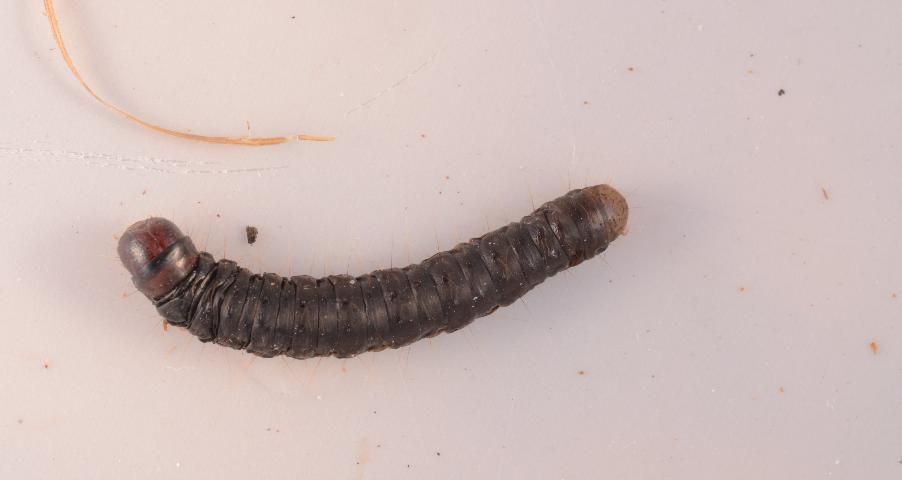
Credit: Lyle Buss, UF/IFAS
Simplicia cornicalis Distribution
Simplicia cornicalis was first documented in central Florida in 2004 and by 2014 had been found in Lee County, south Florida. The species is known throughout Southeast and East Asia, from India to Southern Japan, to Australia and New Guinea, as well as from Hawaii and the South Pacific Islands. It is a cold-tolerant tropical species found as far north as Gainesville, Florida, and west to southern Louisiana, both areas frequented by winter frosts. It has been collected in Texas since 2013. Its eventual spread throughout the Southeast, Mexico, and Central America is possible. Florida Department of Agriculture and Consumer Services, Division of Plant Industry (FDACS-DPI) has specimens from Alachua, Broward, Collier, Duval, Hillsborough, Lake, Lee, Levy, Marion, Miami-Dade, Monroe, Nassau, Palm Beach, and Volusia counties.
Simplicia cornicalis Caterpillars
The caterpillars have a brown body with dark stripes running lengthwise down the body. Hairs on the body are very short and inconspicuous, and they arise from small, dark bumps. The head capsule has a netlike pattern with narrow dark lines surrounding lighter brown blocks. Similar in size to Hypsopygia nostralis, they are about 20 mm (3/4 inch) long when full grown.
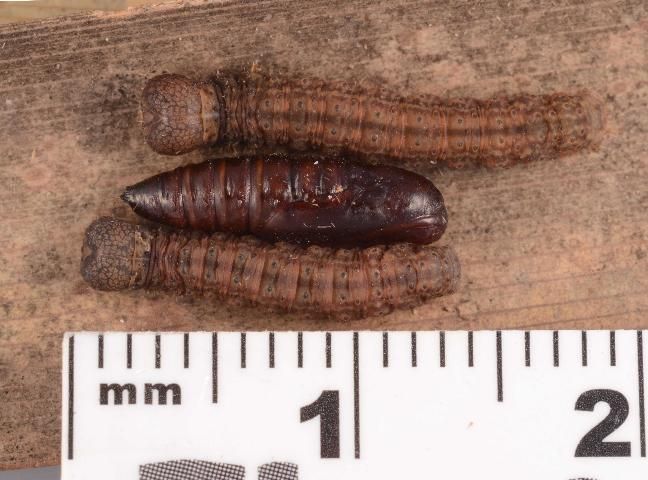
Credit: Lyle Buss, UF/IFAS
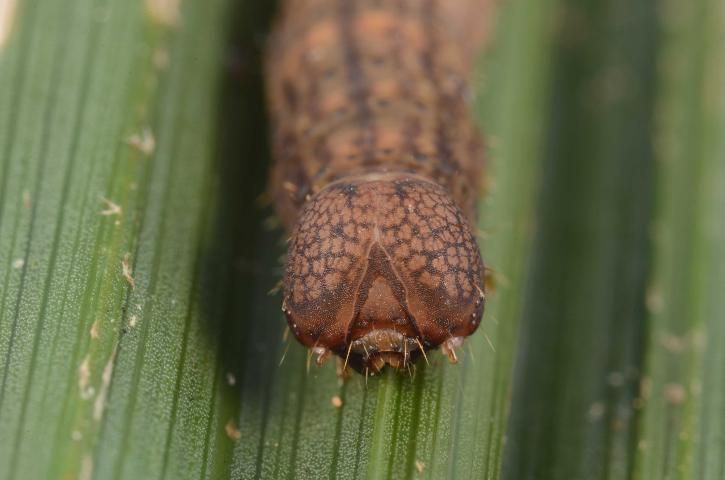
Credit: Lyle Buss, UF/IFAS
Adult Moths
The adult moths of both species are similar in appearance. Hypsopygia nostralis has forewings 8 to 11 mm (5/16–7/16 inches) long, and S. cornicalis has forewings 10 to 13 mm (3/8–1/2 inches) long. The hind wings of H. nostralis have lines near the wing base, whereas S. cornicalis has a yellow line near the margin. Males of S. cornicalis have a tufted knot near the base of the antenna. The antennae of the females are without tufts.
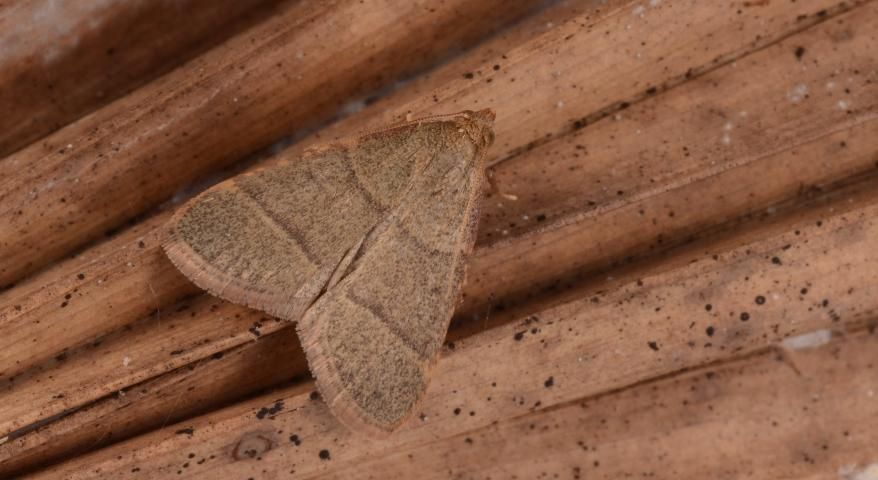
Credit: Lyle Buss, UF/IFAS
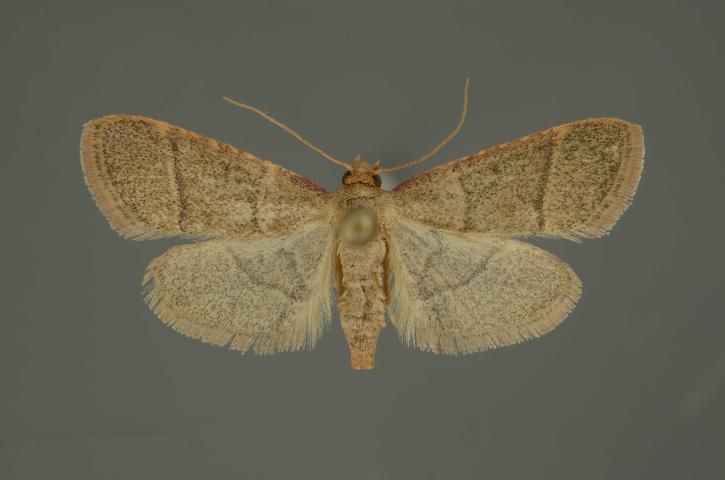
Credit: Lyle Buss, UF/IFAS

Credit: Lyle Buss, UF/IFAS
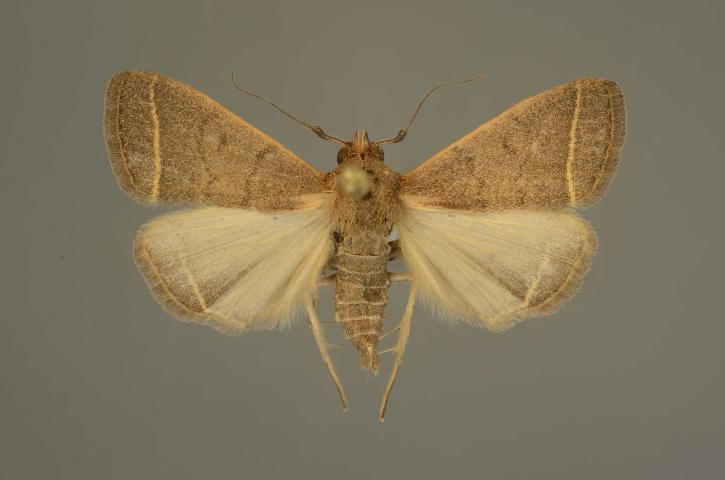
Credit: Lyle Buss, UF/IFAS
What to Look For
Simplicia cornicalis is more commonly found feeding on the thatch of tiki huts than H. nostralis. Palm debris and thatch seem to be the favorite food of S. cornicalis, but H. nostralis can be found on many other dried food sources. Below are details of what we know of the feeding habits of S. cornicalis.
- The caterpillars have not been found on living or dead leaves attached to sabal palms.
- The adult moths deposit their eggs on thatched roofs.
- Caterpillars have been found feeding as soon as two to three weeks after the roofs are thatched.
- Infestations can apparently occur on leaves cut and thatched within the previous six months.
- During the day, the caterpillars conceal themselves among the layers of thatched leaves, which must be searched thoroughly to detect the caterpillars.
- After dark, they emerge from the thatch and feed on the dried thatch on the surface of the roofs.
- Feeding holes and frass from the caterpillars are clearly visible on the layers of thatch.
- The caterpillars are food for frogs, lizards, and birds.

Figure 9. Damage caused by Simplicia cornicalis.
Credit: Stephen H. Brown, UF/IFAS
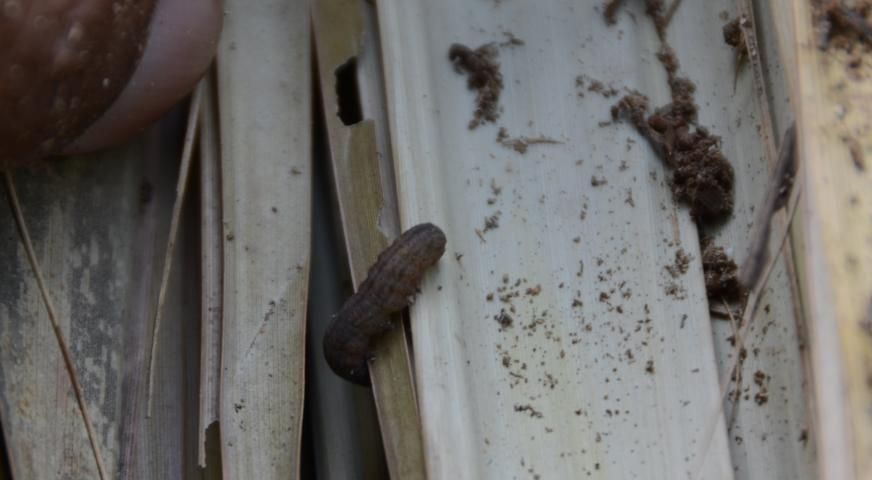
Credit: Stephen H. Brown, UF/IFAS
What to Do
The most effective management strategies are still being worked out, but below is what is recommended.
- For tiki hut builders, pyrethroids such as Scimitar, Talstar, Tempo, or products
Containing Bifenthrin should stave off the caterpillars. Apply by spraying both sides of the fronds before assembling the roof.
- For infested roofs, apply a B.t. (Bacillus thuringiensis) product or Spinosad to the top of the roof. This is best done at dusk when the caterpillars are emerging from between layers of the thatch to feed.
- Getting the products to the caterpillars inside the layer of thatch may be difficult. Use a concentrated spray for greater efficiency.
- Fumigation is allowed but only by a licensed Florida pest control company.
- Read the product labels to ensure that they are registered for this kind of use.
- Read, understand, and follow label directions. The label is the law.
- Once correctly controlled by a spray program, roof re-infestation by tiki hut caterpillars is not likely.
References
Dickel, T.S., V.A. Brou, Jr., and J.B. Heppner. 2010. New North American Records of the Asian Species, Simplicia cornicalis, in Florida and Louisiana (Lepidoptera: Noctuidae: Herminiinae). Lepidoptera Novae, Vol 3. No. 1. P. 53–56. Gainesville, Florida 32614 http://www.lsuinsects.org/people/vernonbrou/pdf/2010%20%20215%20%20New%20North%20American%20records%20%20Simplicia%20 cornicalis%20in%20Florida%20and%20Louisiana.pdf
Lafontaine, J.D., and B.C. Schmidt. 2010. Annotated check list of the Noctuoidea (Insecta, Lepidoptera) of North America north of Mexico. ZooKeys 40: 1–239. doi: 10.3897/zookeys.40.414
Scholtens, B.G. and M.A. Solis. 2015. Annotated check list of the Pyraloidea (Lepidoptera) of America North of Mexico. ZooKeys 535: 1–136. doi: 10.3897/zookeys.535.6086
Swamiappan, M., and M. Balasubramanian. 1979. Simplicia caeneusalis Wlk. (Noctuidae) as a pest of dry palm leaves used in thatched sheds in Tamil Nadu. The Journal of the Bombay Natural History Society 76: 538–539. https://www.biodiversitylibrary.org/item/187445#page/594/mode/1up
Vargo, J. 2007. Simplicia cornicalis. Mississippi Entomological Museum at Mississippi State University, Meridian, Mississippi http://mothphotographersgroup.msstate.edu/species.php?hodges=8339.1